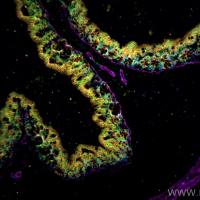Metabolic Labeling and Immunoprecipitation of Yeast Proteins
互联网
- Abstract
- Table of Contents
- Materials
- Literature Cited
Abstract
The proteins of Saccharomyces cervsiae can be metabolically labeled, as described here, with 35 methionine and 35 cysteine or a hydrolysate of E. coli labeled with 35 O4 2? . After the labeling, protocols are provided for the mechanical disruption of the yeast cells or conversion to spheroplasts, with subsequent lysis before immunoprecipitation of the proteins.
Table of Contents
- Basic Protocol 1: Labeling and Immunoprecipitating Yeast Proteins
- Alternate Protocol 1: Making Yeast Spheroplasts
- Support Protocol 1: Endo H Treatment of Immunoprecipitates
- Reagents and Solutions
- Commentary
- Literature Cited
Materials
Basic Protocol 1: Labeling and Immunoprecipitating Yeast Proteins
Materials
Alternate Protocol 1: Making Yeast Spheroplasts
|
Figures
Videos
Literature Cited
| Literature Cited | |
| Byrd, J.C., Tarentino, A.L., Maley, F., Atkinson, P.H., and Trimble, R.B. 1982. Glycoprotein synthesis in yeast. Identification of Man8GlcNAc2 as an essential intermediate in oligosaccharide processing. J. Biol. Chem. 257:14657‐14666. | |
| Cherest, H., Davidian, J.C., Thomas, D., Benes, V., Ansorge, W., and Surdin‐Kerjan, Y. 1997. Molecular characterization of two high‐affinity sulfate transporters in Saccharomyces cerevisiae. Genetics 145: 627‐635. | |
| Graham, T.R. and Emr, S.D. 1991. Compartmental organization of Golgi‐specific protein modification and vacuolar protein sorting events defined in a sec18(NSF) mutant. J. Cell Biol. 114: 207‐218. | |
| Graham, T.R., Seeger, M., Payne, G.S., MacKay, V., and Emr, S.D. 1994. Clathrin‐dependent localization of α1,3 mannosyltransferase to the Golgi complex of Saccharomyces cerevisiae. J. Cell. Biol. 127: 667‐678. | |
| Huffaker, T. and Robbins, P. 1982. Temperature sensitive yeast mutants deficient in asparagine linked glycosylation. J. Biol. Chem. 257: 3203‐3210. | |
| Klig, L.S., Homann, M.J., Carman, G.M., and Henry, S.A. 1985. Coordinate regulation of phospholipid biosynthesis in Saccharomyces cerevisiae: Pleiotropically constitutive opi1 mutant. J. Bacteriol. 162: 1135‐1141. | |
| Marzluf, G.A. 1997. Molecular genetics of sulfur assimilation in filamentous fungi and yeast. Annu. Rev. Microbiol 51: 73‐96. | |
| Reneke, J.E., Blumer, K.J., Courchesne, W.E., and Thorner, J. 1988. The carboxy‐terminal segment of the yeast alpha‐factor receptor is a regulatory domain. Cell 55: 221‐234. | |
| Steiner, M.R. and Lester, R.L. 1972. In vitro studies of phospholipid biosynthesis in Saccharomyces cerevisiae. Biochim. Biophys. Acta 260: 222‐243. |









